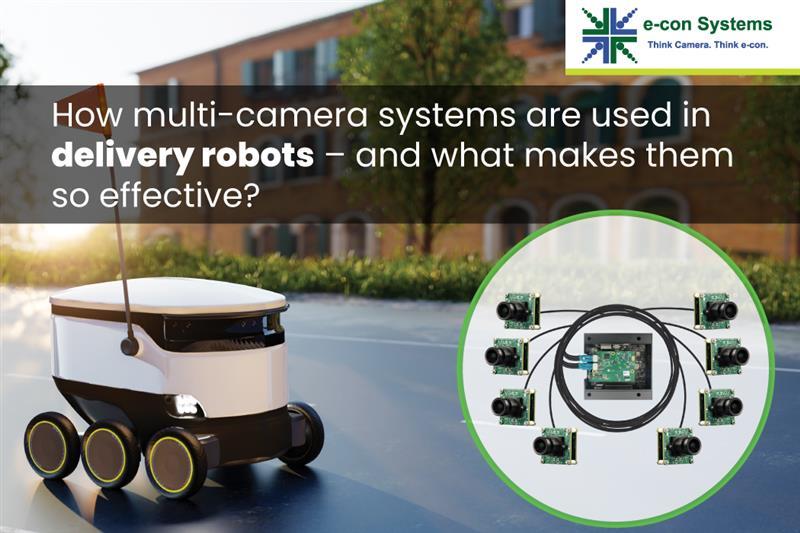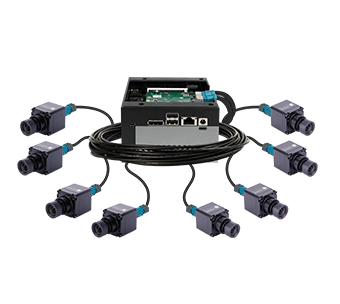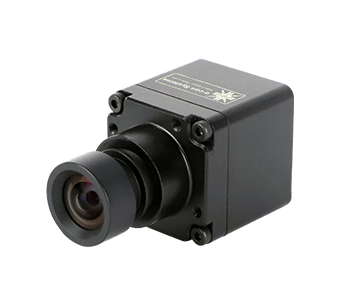Delivery robots have emerged as one of the most promising innovations in the logistics industry. These intelligent machines offer innovative and cost-effective solutions for last-mile deliveries. So, businesses can streamline operations and meet the growing demand for fast and reliable deliveries. One crucial aspect that empowers delivery robots to navigate autonomously and carry out their tasks is the integration of multi-camera systems.
In this blog, you’ll explore the significance of synchronized multi-camera systems in delivery robots and how they enable these machines to operate with high autonomy and reliability.
What are delivery robots?
Delivery robots have reimagined how goods and services are transported. In outdoor environments, delivery robots take on the responsibility of delivering food, packages, and various items to customers’ doorsteps – becoming an integral part of the last-mile delivery process. Indoors, they offer immense value to office spaces, hospitals, restaurants, etc. Within these confined environments, they navigate through corridors, elevators, and hallways to deliver essential items.
Examples of indoor and outdoor delivery robots:
- Last-Mile: Packages, food, groceries, and other goods
- Hospital Logistics: Medications, medical supplies, and documents
- Office and Campus: Documents, office supplies, and other items
- Retail: Inventory management, restocking, and retrieval for online orders, etc.
- Mail and Parcel Services: Parcel sorting, distribution, etc.
How do delivery robots work?
Delivery robots operate through a combination of advanced technologies that enable them to navigate autonomously and efficiently carry out their tasks. These robots use cameras and sensors to perceive their surroundings, capturing visual data from multiple angles. This data is then processed in real time, allowing the robot to:
- Detect and avoid obstacles
- Identify paths
- Make navigational decisions
Furthermore, AI algorithms and mapping software enable the robot to create a detailed environmental map, ensuring it can adjust its movements as needed during its journey.
Why do delivery robots need multi-camera systems?
Autonomous navigation with multiple perspectives
Multi-camera systems play a pivotal role in achieving this capability. By equipping delivery robots with multiple cameras placed strategically around their bodies, they can capture visual data from various angles. This surround view allows the robot to gain a better understanding of its surroundings, ensuring that it can make informed decisions during its journey.
Accurate perception through synchronization
The multi-camera system must be precisely synchronized to achieve seamless autonomous navigation. As the robot moves through its environment, it relies on real-time data captured by its cameras to make instantaneous navigational decisions. Accurate synchronization ensures that the information from all cameras is aligned correctly, reducing delays and potential errors.
Real-time navigational decisions
The ability to make real-time navigational decisions is critical for delivery robots, as they encounter various obstacles and challenges during their journeys. Leveraging the synchronized data from the synchronized multi-camera system, the robot can quickly detect and identify obstacles in its path. This empowers the robot to make split-second decisions, such as adjusting its trajectory or finding alternative paths to reach its destination efficiently and safely.
360-degree environmental map
Delivery robots equipped with synchronized multi-camera systems have the unique advantage of generating a 360-degree view of their environment. As they move, the cameras capture continuous data, which is then processed and used to construct a detailed map of the surroundings. This dynamic mapping allows the robot to adapt its movements in real-time, ensuring that it can avoid unexpected obstacles or changes in the environment during its journey.
More autonomy and reliability
Integrating synchronized multi-camera systems goes a long way toward providing a substantial boost in the autonomy and reliability of delivery robots. It helps them perceive their environment from multiple viewpoints and enhances their situational awareness while reducing the chances of collisions and accidents. Also, reliable autonomous navigation reduces the need for human intervention, resulting in a more streamlined delivery process.
e-con Systems’ world-class multi-camera systems for delivery robots
e-con Systems offers a variety of cameras that power AMRs, like delivery robots, including vision cameras, depth cameras, barcode scanning cameras, surround-view cameras, etc. We have helped several clients find the best-fit synchronized multi-camera system based on their unique requirements.
Our recently released STURDeCAM31 is a 3MP GMSL2 HDR IP69K camera with a 15 meters coaxial cable – perfect for your delivery robots. Its automotive grade 3MP CMOS sensor and the Image Signal Processor (ISP) ensure unmatched image quality. Based on the 1/2.42″ ISX031 CMOS image sensor from Sony®, STURDeCAM31 also comes with HDR capability to ensure great performance even in difficult outdoor lighting conditions along with LFM (LED Flicker Mitigation) for exceptional image capture with pulsed light sources like LEDs. This camera is also equipped with functional safety features to ensure reliable operations of the ADAS in critical environments.
Get more info about STURDeCAM31 here
View our Synchronized Multi-Camera Solutions page, or check out the Camera Selector page for our complete portfolio.
Need more details on how we can help integrate world-class multi-camera systems into your delivery robots? Please write to camerasolutions@e-consystems.com.

Gomathi Sankar is a camera expert with 15+ years of experience in embedded product design, camera solutioning, and product development. In e-con Systems, he has built numerous camera solutions for robots, industrial handhelds, quality inspection systems, smart city applications, industrial safety systems, and more. He has played an integral part in helping hundreds of customers build their dream products by integrating the right vision technology into them.






